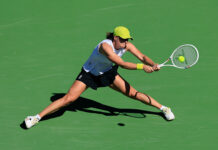Bill Simons
Madrid
It’s exciting – the Davis Cup has a sparkling new format. Instead of being spread out over eight months, 18 nations have come to Madrid for a week to compete on a fast indoor court at high altitude in a round-robin format with six different groups and matches that are just the best of three sets. America has a new captain, former world No. 7 Mardy Fish, and a powerful intergenerational team of three young emerging stars and two veterans. Davis Cup rookies Taylor Fritz, No. 31, and Riley Opelka, No. 37, as well as Frances Tiafoe, No. 47, will team up with former Wimbledon semi-finalist Sam Querrey, and the man who Fish said is the best individual doubles player in the world, Jack Sock.
***
On a cold windswept Sunday afternoon as I approach Madrid’s Magic Box tennis complex, the first sign I see touts the World Cup of Tennis. “That’s different,” I think. I’m used to it just being called the Davis Cup. Then I pass by a random storefront, the Cerrajeria-Herreria elevator repair shop. Their sign says “rehabilitacion and adaptcion.” What a good omen. The Davis Cup, which has long had its ups and downs, certainly was due for some rehabilitation and adaption.
Unfortunately, once I’m inside the Magic Box complex, I get a sinking feeling. Usually Davis Cup press rooms, whether in Spain, Zimbabwe or California, are beehives of familiar activity, with many American journalists. Yes, I hear Spanish, Italian, Japanese and Russian voices, but I’m the only American reporter in the place. Relax, I tell myself. Barcelona soccer superstar Gerard Pique has reassured us. The unlikely architect of all this radical change has said, “I want this to be the best week of people’s lives.” The Davis Cup has signed up with Pique’s group Kosmos for $3 billion over 25 years. “This better work,” mumbles one colleague near me.
All the while, critics say the Davis Cup has lost its soul, it’s become a triumph of money over sport and it’s stuck with a dismal end-of-the season date. But wait, this still is tennis’ greatest team competition, with a 119-year heritage. And just 15 years ago over 30,000 Spanish fans descended on a Seville soccer stadium for three days to see their team, which included a teen named Nadal. This year the US is in a compelling group. On Tuesday we face Canada, with its charismatic young “We the North” whiz kids Dennis Shapovalov and Felix Auger-Aliassime. Then on Wednesday we take on Italy, with the world No. 8, the suddenly-rising Matteo Berrettini, and the always watchable Fabio Fognini, who we say has the best strut in sports.
But forget about body language, let’s just talk about bodies. The Davis Cup was revamped in large part because the top players weren’t showing up. “If you change it, they will come,” Davis Cup insurgents seemed to say. But, the number 3 through 7 players in the world will be missing. There will be no sign of that stadium-filler Roger Federer. Top-tenners Dominic Thiem, Daniil Medvedev, Stefanos Tsitsipas and Alexander Zverev will be absent, along with other gliterati such as John Isner, Stan Wawrinka, Milos Raonic, the injured Juan Martin del Potro, and last year’s hero, Croatian Marin Cilic. Still, Nadal, Djokovic, Andy Murray, Nick Kyrgios, Gael Monfils and Jo Willie Tsonga will play.
Unfortunately, the Davis Cup will be televised on the obscure FS Sports 2 Network and America’s first two matches will be relegated to the No. 2 Stadium because Spain will be on Center Court.
Still, America’s players were upbeat. We do have a 15-0 record against Canada, but we haven’t played them since 1965. Our lighthearted squad said they were pushing each other and felt it’s an honor to play. Jack Sock took a playful swipe at Canadian Shapovalov, whose rap song at Indian Wells was panned. “We’ll take them on in a rap battle,” Sock joked. The struggling American added, “It’s pretty easy to say whatever happens here will be a high note [for me] compared to my year so far.”
Others have not been in a joking mood. Last week Federer claimed that the Davis Cup was “in danger of becoming the Gerard Pique Cup.” Australian Captain Lleyton Hewitt told Aussie TV that he was still critical of the new format and that five-set matches and all those high-passion home and away ties were essential.
Russian tennis czar Shamil Tarpischev told IT, “I am a veteran of 93 ties and an advocate of the traditional Davis Cup that was classic chess, versus the blitz chess we have now.” He added that the new format hurts smaller countries, where hosting Davis Cup ties was a boon for their nations. But he cautioned that this was “not the time for discussions because we are now enjoying a true festival of tennis.”
Davis Cup officials have unleashed a mighty local marketing blitz and paid hefty fees to the players. And if Rafa puts the competition on his shoulders and the Spaniards go far, many a problema could be solved. Some 3,000 adoring fans came out today just to see him warm up. They shrieked “Rafa!” and mightily cheered his practice winners. While there were reports of dreary ticket sales and some wondered whether locals will turn out when Columbia battles Belgium, others were upbeat. “We’re excited for this new era,” said Captain Fish. “There’s nothing like playing for your country, your team and your friends.”
Sir Andy Murray, who’s been through a thing or two in his career, was both upbeat and a bit skeptical: “A lot of us are quite excited to see what it’s going to be like. It’s a big change. It’s been cool to see all the teams and all their colors. We’ll see what happens in a few days.”
Exactly. In a week, will we be celebrating a triumphant mid-course Davis Cup correction that will shock the sport or, as Federer seemed to suggest, will it prove to be “Pique’s folly?”


















